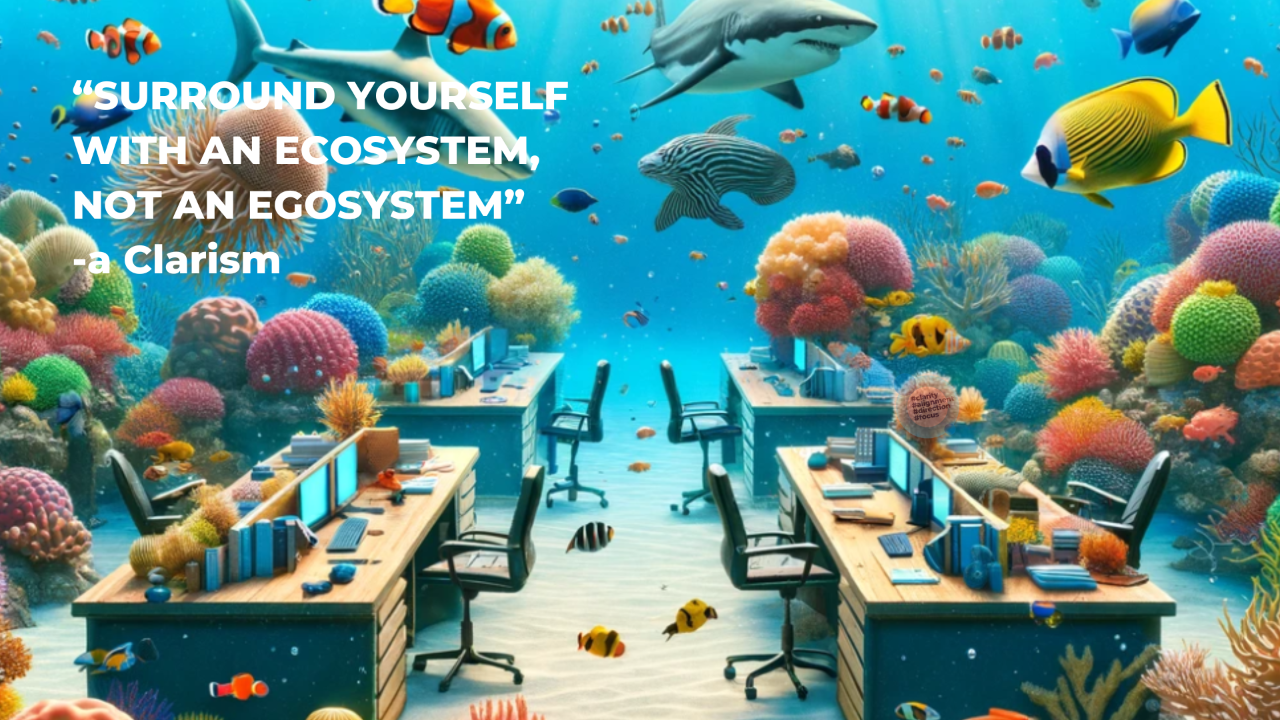The Great Barrier Reef Company
Apr 17, 2024
Ecosystems, Not Egosystems: A Rally Cry for Modern Leadership
Picture this...the Great Barrier Reef is a sprawling and vibrant underwater metropolis, bustling with diverse marine life.
Each species, from the tiniest plankton to the majestic humpback whale, plays a crucial role in the reef’s health and balance.
Now, imagine if this intricate web of life decided to operate solo, with each creature focused solely on its own survival, oblivious to the others. Chaos would ensue, with the delicate balance disrupted, leading to the decline of this once-thriving ecosystem.

This vivid scene serves as a powerful metaphor for business owners. Turning a company into an ecosystem rather than an egosystem means shifting from a mindset of individual agendas and isolated departments to one of collaboration, where every role and function are interconnected and essential to the overall health and success of the organization. Just like in the reef, where the survival of each species is interdependent, a business thrives when its people, processes, and strategies are aligned and working harmoniously towards a shared vision.
So, as a business owner, how can you cultivate an ecosystem that not only survives but thrives? By fostering an environment where collaboration is the current that keeps every part moving forward, adapting to changes as seamlessly as the creatures of the Great Barrier Reef.
If we think of the Great Barrier Reef as a company, it offers some compelling lessons on adaptability, resilience, and managing change. Here’s how the "why" and "how" of the reef’s evolution can be translated into business strategies:
Why a Company Needs to Evolve
Adaptation to Market Changes: Just as the reef adapts to environmental changes, a company must evolve to stay relevant in its market. Changes in consumer preferences, technological advancements, and competitive landscapes are like the ecological shifts in the reef’s environment. Companies that can adapt their products, services, and operations to these changes are more likely to survive and thrive.
Genetic Diversity—Corporate Style: In a company, diversity isn’t about genetics but about ideas, skills, and perspectives. Just as genetic diversity in the reef leads to more resilient species, a diverse workforce can enhance a company’s problem-solving ability and innovation, enabling it to navigate challenges and seize opportunities.
Impact of External Pressures: Companies, like reefs, face external pressures—economic downturns, regulatory changes, and social shifts. Understanding these pressures and responding effectively is crucial for sustained success.
How a Company Can Evolve
Innovation as a Response to Stress: In response to stress, corals may bleach, but those that survive become more tolerant of new conditions. Similarly, companies under pressure can innovate to find new ways of doing business, developing products, or entering markets that may not have been considered before. This resilience can open up unexpected opportunities.
Migration to New Markets: Just as species in the reef may shift their range to find more suitable conditions, companies might look to new markets or demographics as old ones become saturated or less profitable. This can involve geographical expansion, exploring new customer segments, or even diversifying into new product lines.
Developing New Capabilities and Relationships: The evolution of new species interactions on the reef can inspire companies to look at new partnerships and collaborations. By working together, companies can leverage each other’s strengths, much like symbiotic relationships in nature. This might mean partnering with technology providers, merging with or acquiring other companies, or even forming alliances within their industry to tackle common challenges.
Adopting an ecosystem approach allows the Great Barrier Reef company to harness the dynamic interplay of diverse elements, fostering innovation and resilience in the face of environmental and economic challenges. By operating as an ecosystem, the company benefits from enhanced adaptability, enabling it to respond swiftly and effectively to new opportunities and threats, much like a living, breathing organism. This model promotes sustainable practices and growth, ensuring that every part of the organization contributes to the health and longevity of the whole, crucial for long-term success. Conversely, a rigid business operating system lacks the flexibility to adapt to the complex, ever-changing demands of today's global market, potentially stifling creativity and progression.
Applying these natural lessons to business, the metaphorical "Great Barrier Reef Company" becomes a pioneer in its field, constantly adapting, diversifying, and innovating in response to internal and external challenges. It’s a dynamic model of growth and resilience that asks: how can we transform pressures into pathways for new opportunities?
Now, don’t you think this perspective could inspire some fresh strategic thinking in today's corporate world?
What kind of "evolutionary adaptations" do you think would be most beneficial in your industry? In your business?
Dave Clare, Chief Evolution Officer
WEEKLY CLARISM

Please see above...you get the point.
